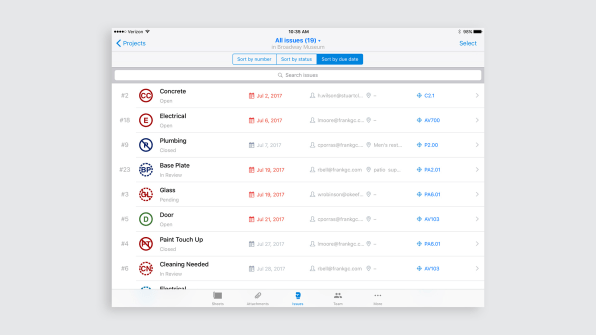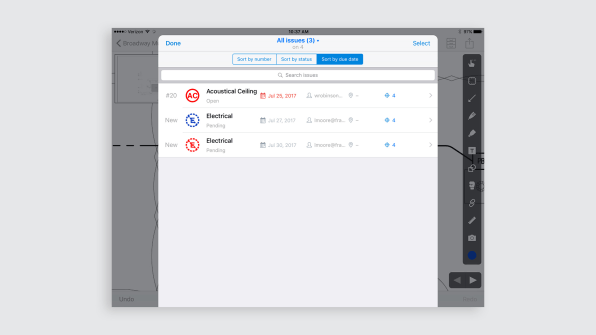Ux Design Mobile App Vs
Alissa Briggs is head of design at the construction industry startup PlanGrid. She spoke to Doreen Lorenzo for Designing Women, a series of interviews with brilliant women in the design industry.
Doreen Lorenzo: Tell us about the path you took to get to PlanGrid.

Alissa Briggs: I've always been interested in using design and technology to solve problems. My mom used to own a toy store that was focused on providing high-quality toys around a time when all these plastic, cheap toys were coming out. So I used to spend a lot of time in that store seeing how my mom was creating this great experience for people, and bringing in quality toys that would actually last for years and create great connections with the kids and the families who were playing with them. I did a lot of work to help her create a website and other things that would extend this experience into the digital realm. I started to get interested in how we use technology as this medium for creating emotional experiences and being utilitarian at the same time.
I worked at Intuit for a while, using technology to improve the lives of small business owners. Then I worked at a small social network startup where we were using technology to solve real-world problems, and so when I heard about PlanGrid and how they were using technology to solve the big, meaningful problem around how we build infrastructure and buildings, I was intrigued.
DL: What is PlanGrid, and who is using it?
AB: PlanGrid is construction productivity software that allows contractors and owners in commercial, heavy civil, and other industries to collaborate easily from their mobile devices and desktop, managing blueprints, specs, photos, RFIs, field reports, and punch lists. The user might be a building owner or developer, or designers and engineers, general contractors, and subcontractors. Then you have things like auditing and inspections. Then there's the facilities and management of the building after it's been built. There are many different types of people who are working on different aspects of that process, and they all have different needs. PlanGrid is used throughout that entire process.
What that means from an experience perspective is we need to design for both the guy who's sitting in the office with his vision for what his building's going to be, and the person who's got the hard hat and work boots on and is needing to reference the plans throughout.

DL: Why do you think design is relevant in the construction field?
AB: Design could not be more important than in the field of construction. I quickly found when I joined PlanGrid that many of our customers have never used computers. Some of them don't even have email. So it's critical that any new thing we build be simple to use.
People are incredibly busy, in chaotic environments with a million things happening around them. They don't have the luxury to sit down and learn a new tool, to go through a 10-page workflow to get a simple task done. Design needs to be thinking about how to craft experiences in a way where people can learn them very quickly so that anything someone needs to do, be it capture a partner's photo, share a problem with colleagues, or resolve a problem, can be just one tap away.
DL: Do you think that you're at the beginning of something, in terms of how design can shape the construction industry for the better?
AB: Absolutely. There are many aspects of designing for construction that are really different from designing for other industries. When you think about some of the other big players that are out there designing software today, you can safely assume that you've got a tech-savvy customer who's sitting in front of a computer doing this one task, and you've got this person's attention for the entire time. That is not the case in the world of construction. By taking a weightier focus on the construction segment versus trying to solve for just office workers, we're going to be able to make a huge impact on this space that a team without this design lens on it would not be able to make.
DL: Is it difficult to instill design thinking in an industry that hasn't typically emphasized it before?
AB: The reality is that great design and great user experiences start from the top. It has to be baked into the culture. I've seen a few companies that over time have been able to build a design-centric culture. But more often than not, it's a difficult transition. I'm not saying it can't be done; it's just very difficult.
We are starting to see more startups and new companies, or even new leaders, who are very design-centric, and the good news is that there is plenty of evidence that it absolutely contributes to the bottom line.

DL: How do you lead your team to get new ideas implemented?
AB: Everything comes back to a focus on the user. What I've found is it's not enough to just have your design team thinking about the customer. You need everyone in your organization thinking about and valuing the customer. We actually have everyone—from the CEO to the sales, finance, engineering, design, and research teams—go out to job sites to spend time with our customers. This is not a once-a-year special occasion; this is something we're doing constantly.
For example, a couple months ago I went out to a 55-story skyscraper with a team—a couple designers, some support, engineers, and other folks. We get our hard hats on, we go up to the 55th story. There are no walls on this building. There's wind coming through.
When you're up there in two inches of standing water (it had rained earlier), and it's windy, and you're kind of afraid for your life, it gives you this whole new sense for what it's like to actually build on the job site. They're risking their lives to build the buildings that keep us safe, that shelter us—our hospitals, our schools. Their work inspires us to work better for them. That is important—getting the whole team out in the field and really falling in love with the customers and with solving their problems.
Ux Design Mobile App Vs
Source: https://www.fastcompany.com/90150354/how-do-you-design-ux-for-someone-whos-never-used-a-computer
Posted by: lopezprolent.blogspot.com

0 Response to "Ux Design Mobile App Vs"
Post a Comment